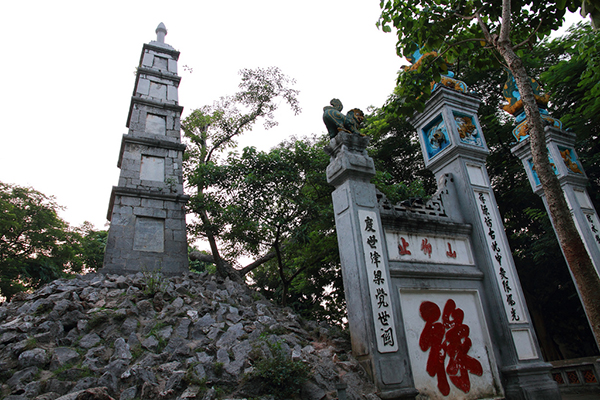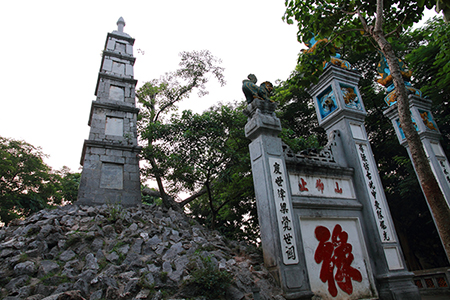To the freshly-arrived tourist in Hanoi the guide will most certainly show the temple named the Jade Mountain (Ngoc Son) built on an islet in the Lake of the Restored Sword (Ho Hoan Kiem) an expanse of green water with a bonier of lawns, flower-beds and age-old trees - the jewel of the capital city. Here was located a country villa of the Trinh seigneurs in the 16th-18th centuries. In the 19th centure the site became a Buddhist pagoda, then a temple for the cult of deified warriors1, the Spirits of the Soil, of Medicine and of Literature.

The architectural complex, like the Van Mieu (Temple of Literature dedicated to Confucius), is bathed in an atmosphere of letters and humanistic culture. It comprises a gate standing behind a ceiba tree whose red flowers bloom in April, an obelisk in the shape of a pen brush, an arched gate topped by a stone inkslab and a graceful red wooden bridge dubbed "Perch of the Rising Sun" (The Huc) leading to the islet. Here are the shrines and a structure built out into the lake, called the Break-water Pavilion (Tran Ba Dinh).
The tall, tapering stone pillar in the form of a pen brush bears three ideograms: "Ta Thanh Thien" which mean: Writing on the Blue Sky. Together with the temple, it was designed by the scholar Nguyen Van Sieu (1799-1872) whose talent and fame was only equaled by that of his friend Cao Ba Quat (1809-1854): In literary circles the two were extolled as "divine" (Than Sieu, Thanh Quat). by their disgust at the depravity of the court and their sympathy suffering of the people, both left the corrupt mandarinate. Cao Ba Quat joined the command of the peasant revolt known as the Rebellion of the Locusts. Nguyen Van Sieu, of a more peaceful temperament, devoted himself to educational and cultural work. He trained brilliant disciples at the Square Pavilion (Phuong Dinh) built close to his house in Hanoi (in the present Brick Street or Nguyen Sieu Street, Nos. 12-14). Besides collections of beautiful prose and poetry. He left studies on literature, philosophy, geography... The people of Hanoi are in particular thankful to him for this magnificent gift: the Temple of Jade Mountain.



